I’ve been watching a mated pair of Swainson’s Hawks near Monida, Montana all summer and for several reasons I believe their first nesting may have failed and they started over. They are now rearing two late juveniles that are still very young and immature for this late in the season. Neither bird is hunting on its own and both are still awkward and clumsy though they can fly reasonably well.
They spend their day perched on poles, posts or on the ground as they wait for their parents to bring food (voles) and they scream almost incessantly in their impatience to be fed. One of the siblings has an injured leg but this sequence of images, taken last week, involves the uninjured bird.
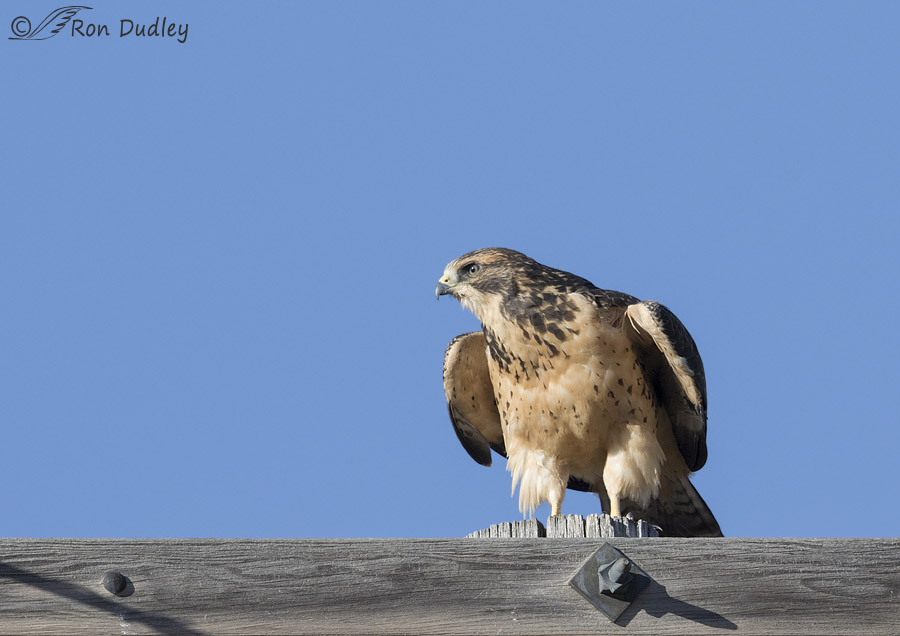
1/1600, f/7.1, ISO 500, Canon 7D Mark II, Canon EF500mm f/4L IS II USM, not baited, set up or called in
As the young hawk waited to be fed it often perched on this power pole or its crossbeam but it sometimes made short hops/flights to different positions on the pole in an apparent effort at practicing take-offs and landings. One of its favorite places to land was on a short piece of wire stretched between two insulators just out of frame to our left. The relatively narrow wire isn’t a particularly stable perch but the youngster seems to prefer the wire over the insulators.
I had fun photographing these short take-offs and landings because they were awkward and included a lot of missteps and wing-flapping. Here the bird is looking at the wire just a few feet to our left and preparing to take off and (hopefully) land on it.
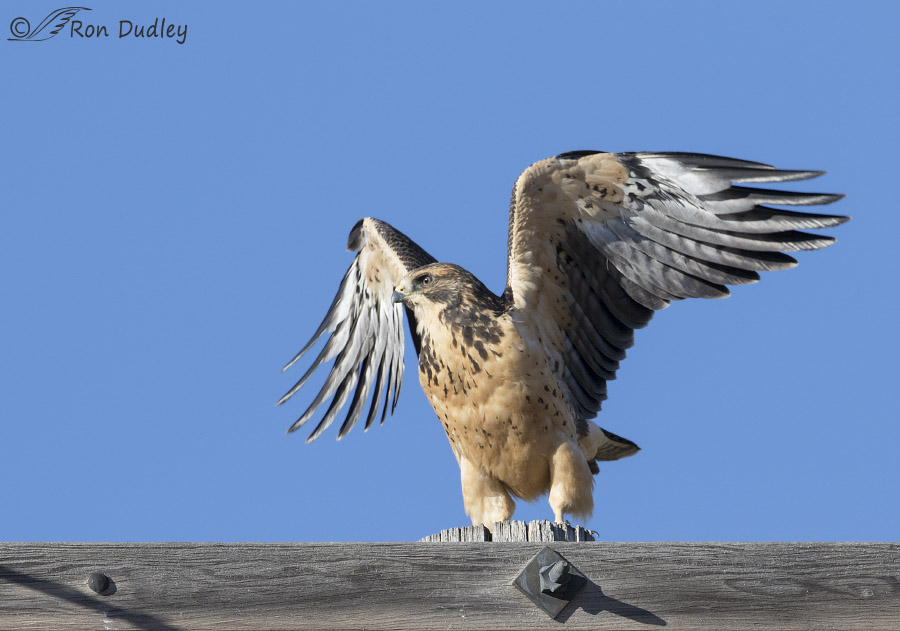
1/1600, f/7.1, ISO 500, Canon 7D Mark II, Canon EF500mm f/4L IS II USM, not baited, set up or called in
Because the bird is young and inexperienced and because the next potential perch is so close and slightly above it, the angle of take-off is somewhat unusual. Instead of pushing off forward and down and using the force of gravity to gain momentum…
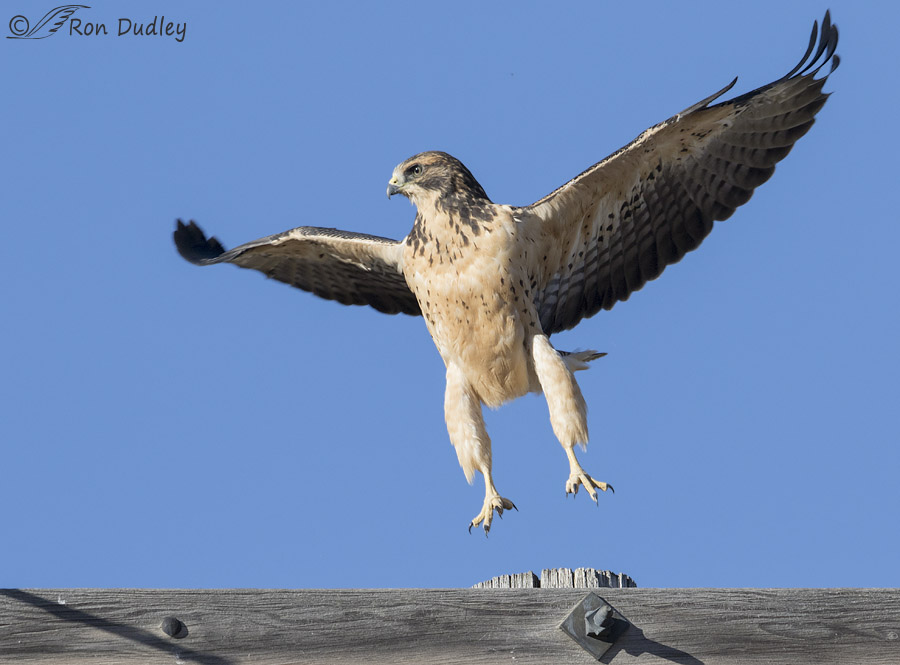
1/1600, f/7.1, ISO 500, Canon 7D Mark II, Canon EF500mm f/4L IS II USM, not baited, set up or called in
the hawk jumped almost straight up on the first flap of its wings.
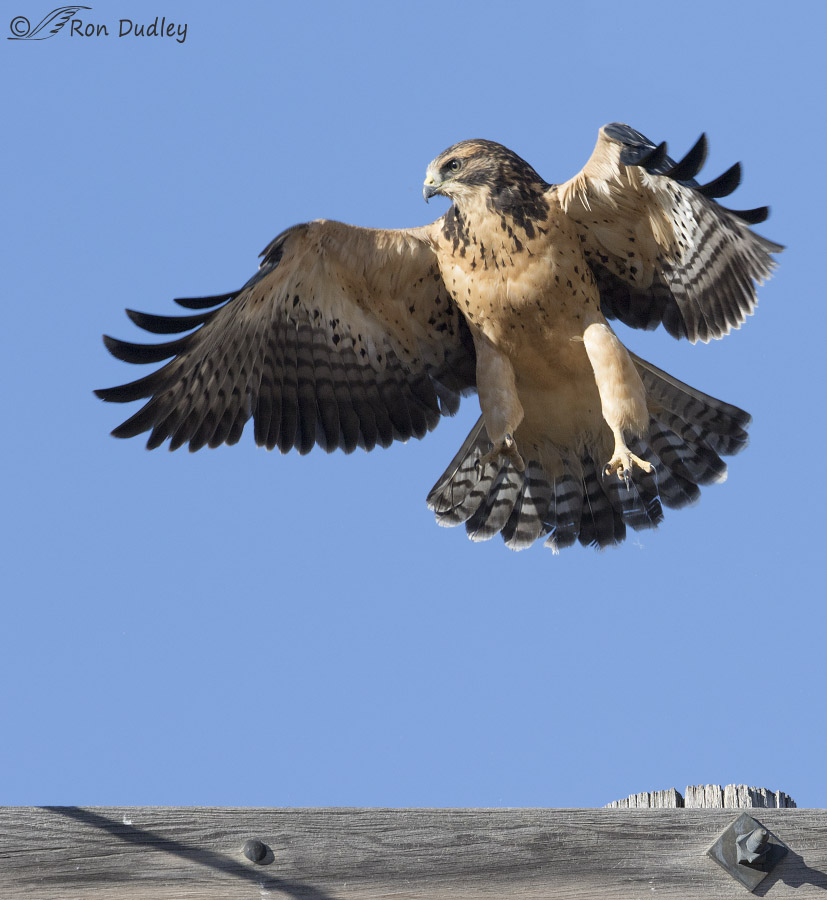
1/1600, f/7.1, ISO 500, Canon 7D Mark II, Canon EF500mm f/4L IS II USM, not baited, set up or called in
In the next frame the body of the bird is still in an almost vertical position and its eyes are still glued to the wire out of frame to the left. I wasn’t prepared for this vertical jump so I cut off most of the bird in three of the following frames but…
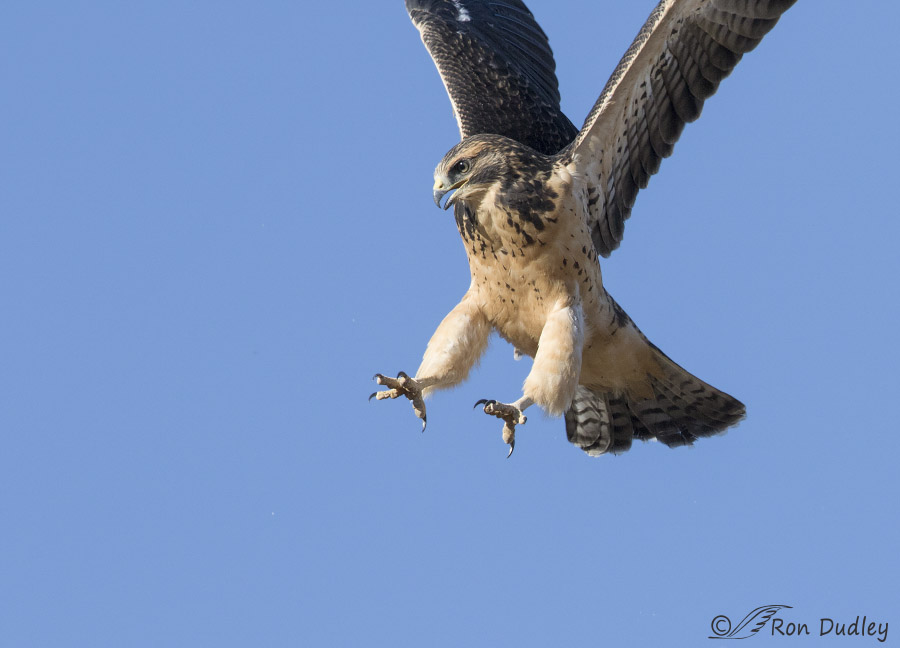
1/2000, f/7.1, ISO 500, Canon 7D Mark II, Canon EF500mm f/4L IS II USM, not baited, set up or called in
I decided to include this one as the hawk began to descend toward the wire because it shows the outstretched feet and the focus of its eye on the soon-to-be perch.
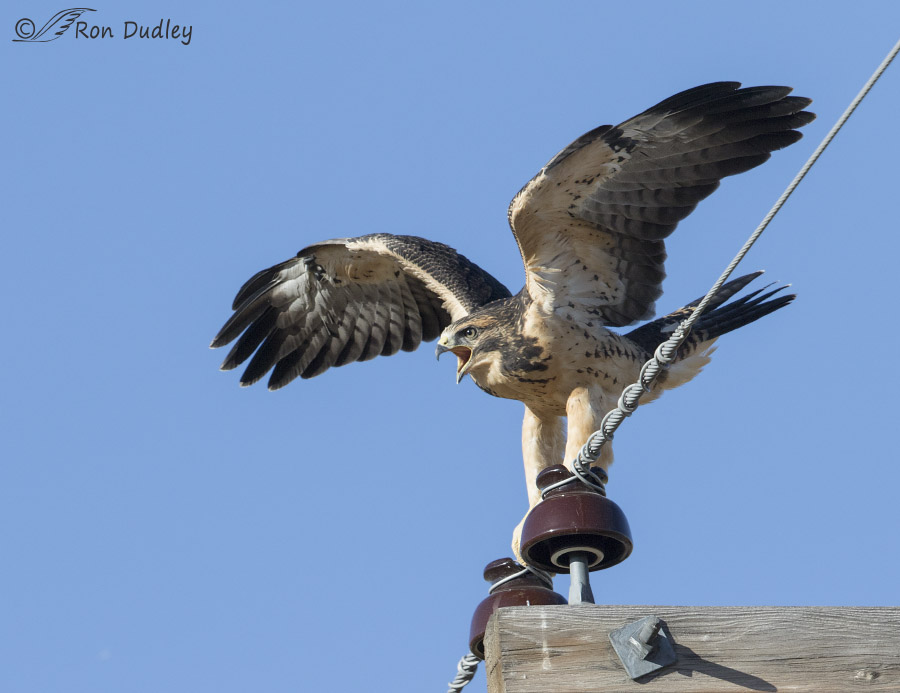
1/1600, f/7.1, ISO 500, Canon 7D Mark II, Canon EF500mm f/4L IS II USM, not baited, set up or called in
The next shot I was able to get without cutting off any body parts shows the bird just after landing as it attempts to stabilize itself on the wire. It seems to be screaming in exaltation and celebration of its landing success but I suspect it was just calling out to its parents for more food.
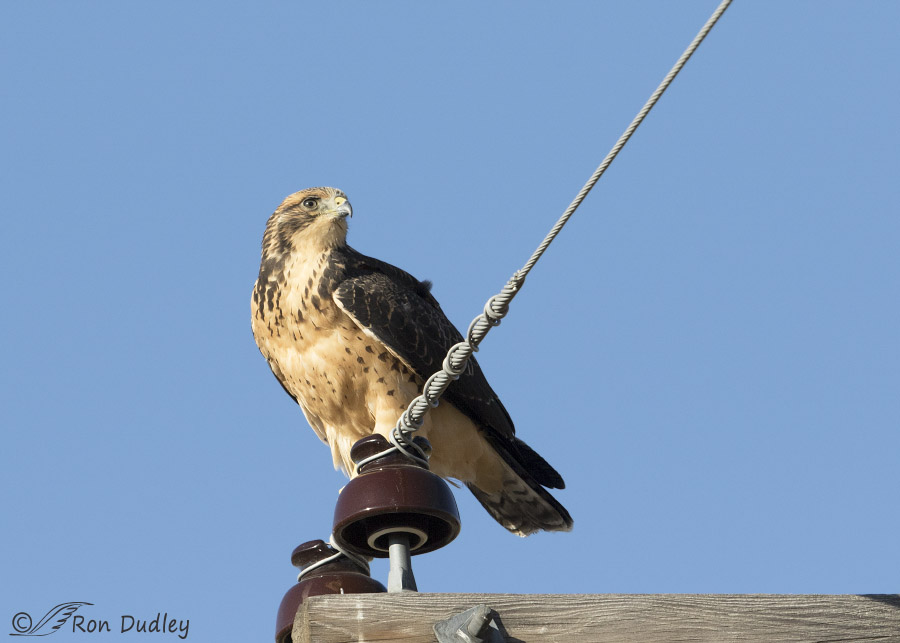 1/2000, f/7.1, ISO 500, Canon 7D Mark II, Canon EF500mm f/4L IS II USM, not baited, set up or called in
1/2000, f/7.1, ISO 500, Canon 7D Mark II, Canon EF500mm f/4L IS II USM, not baited, set up or called in
It soon settled in on its perch and scanned the skies for a returning parent. The siblings were wonderful watchdogs – they always spotted a returning parent long before I could and as a photographer who loves to photograph raptors in flight I was very appreciative of the heads-up.
I’m concerned about these two young birds. They just don’t seem mature enough to survive the grueling migration of the species to South America that is already beginning and the bird with the injured leg has an additional strike against it.
I hope they both have a reasonable chance of making it. I’ve become quite attached to them.
Ron
PS – In two of these photos I’ve removed a short piece of wire and in one of them part of an insulator. I also added canvas to one image.


Beautiful shots! I love these; even the one with the wings cut off.
Sensational shots Ron! I hope they make it to be self sufficient!
Charlotte
Fingers and toes crossed they do make that huge flight successfully.
Love the poses, and that upward leap makes me smile. Broadly.
And I am v pleased to share my love of, and appreciation of britches.
Thanks, EC. I even told someone on FB today that you call them “britches”.
In the last shot, I’m anthromorphizing but… it looks like “HA HA HA. I told you I could do it.” to its sibling. And the jumping straight up made me laugh. 😀
The bird did seem pretty proud of itself, Arwen.
I’m wondering if the chicks and the parents might migrate together? The Sandhill Cranes families that winter here somehow manage to arrive together. And even if that is not the usual pattern, I wonder if we really know if they might. Is this possible?
“I’m wondering if the chicks and the parents might migrate together”
Well, Swainson’s Hawks migrate in huge flocks of up to 5 – 10 thousand birds so they might be together but it sure seems like they would have a difficult time keeping track of each other.
Ok, I just did a little research – here’s what BNA Online has to say on the subject:
“Juveniles associate with parent birds for average of 29.2 d (range 22–38 d) after fledging. At 11–20 d after first flight, they (juveniles) left nesting territory, did not return. Once they (juveniles) left nesting areas, they did not appear to be provisioned by adults”.
Where was the other young bird during this series? Is there any chance of an immatute bird, especially a disabled one, making it part way in their migration or do their instincts work against them, forcing them to try to make it the whole, maybe impossible, distance? Mother Nature sure has one HUGE mean streak!!!
Patty, the other juvenile was on another pole about 1/8th of a mile up the road.
I doubt of they would survive if they only made it part of the way because if they don’t make it to the Pampas there presumably wouldn’t be enough grasshoppers for them to eat (their primary winter food).
I try to ignore the sabotage attempts of my evil iPad, but sometimes I just can’t!!! They just come too darned frquently! Some times I think about getting even by not plugging in the charger, but……
This juvenile is just beautiful, and I love all the facial expressions and body positions. I especially like the third photo. Knowing that these birds are not mature enough to make the migration flight tugs at my heartstrings. If the parents’ first nesting failed and these babies are in danger of not making it, the situation becomes even sadder. Sometimes it’s difficult to deal with the reality of nature. I hope these two do make it. (The flight photos are also great displays of the ‘britches’.)
“The flight photos are also great displays of the ‘britches”
Ha, you beat Elephant’s Child to the “britches”, Susan. Not sure she’s going to like that! 🙂
I hope they make it too but to have any chance at all they’ll have to learn to hunt on their own very, very soon.
It was Elephant’s Child who taught me to pay attention to britches. 🙂
Are you sure you didn’t learn that in Jr High School first?…
It’s a long story, Ron, but no I didn’t…
Good stuff, Ron.
Do you carry any type of capture and transport kit on your daily forays or Montana excursions?
Thanks, Neil.
I carry lots of “stuff” on these trips, some of it multi-purpose. I have gloves, towels, wire-cutters (all three came in handy on this trip with the Barn Owl snagged in barbed wire) and a variety of other tools. No “transport kit” though. Having room for everything on these extended trips becomes an issue. Sometimes I think the only thing I’ve left home is the kitchen sink (actually I have one of those with me too, in the camping trailer…).
After the Barn Owl experience I’ve definitely decided to buy a larger, sharper pair of wire cutters and always have them with me. Barbed wire is extremely tough to cut and I actually injured my arm somehow because it took every ounce of my strength to get it done. Took two days to heal but it sure was worth it!
Keep the “rescue kit” and the transport kit in the kitchen sink while you travel….throw them under the bus when you camp…problem solved!
AND, as usual, spectacular shots and observations. It’s particularly special that you’re watching these birds over time. That’s when you get to see the stuff that’s NOT in the books, or when you can see behavior the experts say doesn’t/can’t happen…and yet there they are doing it. 😉 Sure wish this kiddo would choose a safer perch location, though.
“It’s particularly special that you’re watching these birds over time”
Exactly, Laura! Just watching their behaviors through my lens is so interesting that I have to be careful to not forget to click the shutter!
Ron, can you see what kind of injury? The size or type of injury and where on the leg? These young hawks have so many obstacles to survival.
“Ron, can you see what kind of injury?”
No, I can’t, Laura. The entire leg (and foot) looks normal. But when it flies its right leg is nearly always hanging straight down with the other one tucked. And when it’s perched (on a pole, post or on the ground) it never puts any weight on it. It does a lot of hopping. When it’s on the ground with its sibling the injured bird is often laying down while the other one stands. Makes me think that the injury is where the leg attaches to the body.
I tried to catch it once when it was on the ground and seemed to be struggling (I’d have taken it to the rehab center in Bozeman where the Barn Owl entangled in barbed wire ended up) but as soon as I got out of my pickup it took off.
I’ll likely post some shots of the injured bird soon.
WOW! Excellent study of a young Swainson’s, superb images, sharp focus, love the detail!
Many thanks for sharing.
I figured you might like this series, Dick. Thank you.
A wonderful series…Funny the bird would choose that perch to land on…maybe it just liked the challenge. I sure hope it is mature enough for the trip, such a grueling one. It certainly looks well-fed and chunky…now it just to hurry up with those flight skills and build up the necessary stamina…time is running short (keeping my fingers crossed!)…
“Funny the bird would choose that perch to land on”
I thought so too, Patty, and wondered if it was because the insulators were slippery. But in my experience Swainson’s Hawks as a species perch on wires more often than Red-tails do (probably because of the smaller feet of the Swainson’s).
Wow! 🙂 Great, clear photo’s of the hawk both sitting and in motion – really shows it’s personality at the time. They can always surprise us with their actions! I also hope they make it.
Thank you, Judy.